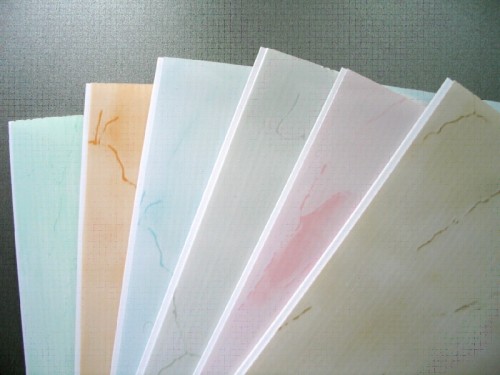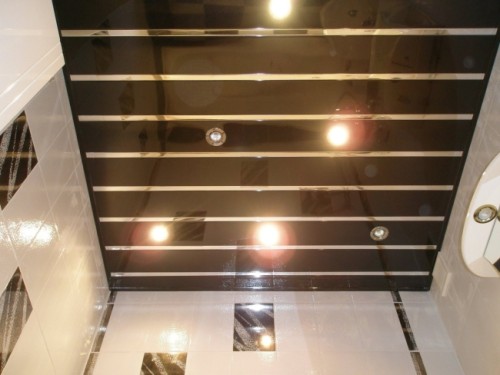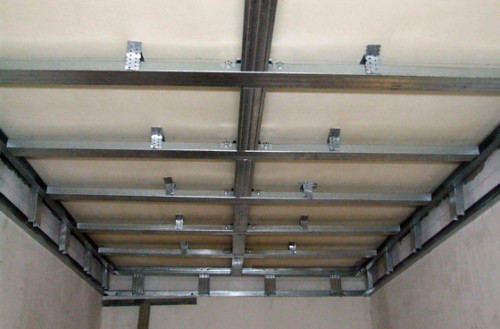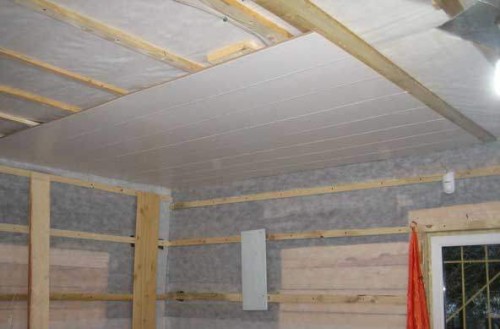
How to shepherd ceiling with plastic panels Ceilings
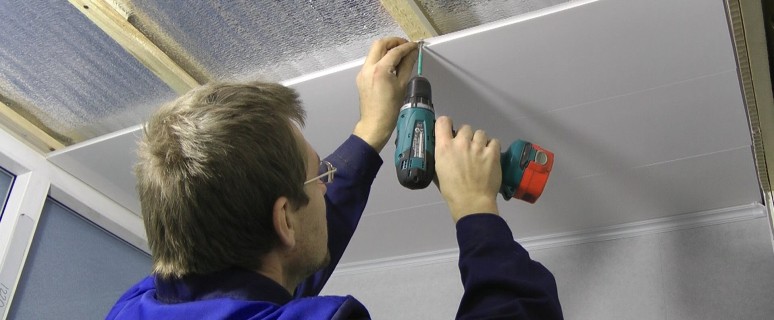
Plastic panels today are very popular. They are squeezed both walls and ceiling. This material has many advantages - ease of installation, low price, acceptable quality. Next, we consider in more detail how to see the ceiling by plastic panels. This information will be useful to those who wish to carry out installation work on their own, without attracting specialists.
Content
Product specifications
Before starting working with any material, it should be recognized by its "strong" and "weak" parties, as well as other characteristics. Thus, plastic panels are plates made of polyvinyl chloride (PVC). Today, they are produced in various lengths, which is 2.3 - 6 m. The width of the panels varies from 10 to 95 cm. The thickness of each plate reaches 5-9 mm. PVC panels are differently called plastic eurogram.
In the context, the panel is a design consisting of facial and rear walls, as well as internal stiffeners. On the sides of each plate there are locks for clutch, called "spike" and "grooves". Thanks to these locks, the panels are closely connected one on the other, forming a one-piece and smooth surface.
This material has many advantages that will be addressed further:
- Plastic panel has a very low weight. And despite the fact that it is pretty light, it has excellent resistance to deformation, which is achieved due to the rigid ribs available.
- Plastic panels "are not afraid" moisture. Therefore, this coating is quite practical and is suitable for installation in rooms, in which there is an elevated level of humidity (bathroom, bathroom, etc.).
- Thanks to its design, these panels can "hide" various wall defects and ceiling (irregularities, potholes, differentials).
- In addition, in the framework of the space between the panel and the ceiling, you can successfully place the available communication lines, thereby hissing them.
- This material has a low cost. This caused its popularity today. In addition, the price of the ceiling of the ceiling by plastic panels decreases if the work is performed by their own forces without attracting specialists.
- The surface lined with this material does not need additional finishes or protection.
- The key advantage of the panels is the simplicity of their installation. This material is supplied with installation, it is easily drilled and cut. And thanks to the technology of Schip-grooves, a one-piece and beautiful surface is obtained.
- Plastic in itself can be called an eco-friendly material. Since microscopic pores are not provided in the panel design, it is protected from various harmful bacteria and microorganisms in it.
- Panels have good sound and thermal insulation properties.
- Thanks to the privacy of the material using PVC panels, you can implement any designer solution.
- Easy to care for PVC plates. For their cleaning, any detergent is suitable. However, refrain from those containing various abrasive elements that can damage the coating.
"Weaknesses" of plastic panels:
- This material is susceptible to fire. Therefore, it is impossible to sow surfaces located near the sources of fire or heating elements.
- Plastic can not be called durable material. It is quite sensitive to any mechanical damage.
- It is impossible to carry a ceiling with plastic panels if straight sun rays fall on the surface. After all, under their impact, the material can fill and turn yellow.
Selection of material
First of all, it is necessary to correctly choose the material for work. What are the requirements of the high-quality plastic panel? We list them.
- The panel should not have any visual defects - cracks, scratches, chips.
- The surface of the surface should be monophonic, without spots.
- The plate should have the right shape, its surface must be perfectly smooth.
- The panels should be securely bonded thanks to the "Schip-Paz" technology. Before buying a material, try to bore a couple of plates, there should not be gaps between them.
There are several types of PVC plates:
- Retain plates. In its appearance resemble lining.
- Panel under the tile. Their installation is no different from the installation of the first type plates. But on their own panels have a more attractive appearance.
- Leaf plates. Their installation differs from the method of installing panels of the first and second type. So, the sheet plates are attached with the help of nails and glue directly to the surface.
How to shepherd ceiling plastic clapboard
Basic moments
Before approaching a detailed description of the ceiling processing process with plastic clapboard, consider the list of major errors that are performed during the installation.
So, what is the gross violation when installing plastic panels? So, in some sources it is indicated that when the ceiling is trimmed, the framework should be constructed from wooden rails using a construction stapler. This is rooted incorrectly. After all, the plastic is most often mounted in premises with high humidity, and the tree, as you know, this moisture is "afraid." In addition, the tree is subject to deformation, rotting, affecting various harmful microorganisms. Also consider, it is not worth using a building stapler for mounting panels. For the framework of the frame, it is better to use a high-quality metal profile. Fastening is carried out by self-pressing with press washers.
There are several ways to cover the ceiling with PVC panels:
- Frameless method. Here the plates are attached directly to the surface, with the help of glue.
- Frame method. PVC plates are fixed on the previously constructed frame from profiles.
Tools and materials
A list of tools and materials needed to cover the ceiling by plastic panels:
- Screwdriver.
- Handling for cutting.
- Level for monitoring the correctness of installation.
- Pencil and ruler for measurements.
- Brush, roller with a small pile.
- PVC panels.
- Profile for fastening.
- Saws.
Installation of panels
It is worth saying that it is possible not only to fade the ceiling with plastic panels, but also the walls of the room. The only difference here will be the complexity of the installation work, because the ceiling is not so comfortable to work as with the walls.
Procedure for installation work:
- Initially, the surface should be prepared for further installation. Naturally, the greater advantage of plastic panels is that they can hide some unevenness of the ceiling, but this does not mean that they need to leave gross defects on it. So, all the large potholes and irregularities should be sharpened.
- When places are found, where the old finish has a fragile clutch, we clean it. If the past coating fits tightly to the ceiling, then you can leave it.
- Next, the entire ceiling with a mixture of deep penetration.
- Then go to the installation of the crate. It is worth saying that there are several ways to lay plastic panels - along and diagonally. If you do not have experience in the installation works of this kind, it is better to use the first installation method. He is somewhat easier.
- If you decide to lay the PVC panels along, then the doomle is done across. Fresh profile on the self-tapping screw. The profile arrangement step depends on the width of plastic panels, but on average it is 30-35 cm. It is very important, the entire frame is built in one horizontal plane. Completely execution of work. Check with a level.
- If the surface of the ceiling is under the tilt, then there are some nuances in its trim. So, before the framework of the frame, it is necessary to determine the lowest part of the surface and mark it. We apply to the lowest point level, and make a mark (that is, the mark will be placed at an altitude of the lowest point plus the width of the mounting profile). Next, at this mark it is worth building the entire frame.
- After installing several profiles, there is a durable thread between them. They will become a kind of markup, which will show how the plane of the future ceiling will look. In addition, the threads will be a reference with the subsequent installation of the profile.
- Next, go to the framework of the frame PVC panels. We place the starting profile by the wall, fasten it with self-pressing with a press washer. Then cut the PVC plate (on the segment of the desired length) and insert one end to the starting profile. Fix.
- All subsequent PVC plates are bonded with each other thanks to the Schip-Paz technology. As for the last panel, it may not come up in width, then it will be necessary to cut it. For this, the logs or hacksaw is suitable. Next, fix the finishing profile to the wall and fix the cut panel using it (according to the same technology, as the first plate was fixed).
- In order to hide all the gaps that were formed between the wall and the ceiling profile, the plinth will be required. Typically, the ceiling plinth is also made of plastic. Fix it around the perimeter of the entire ceiling. On this work on the installation of plastic panels can be considered complete.
It is worth saying about some nuances:
- So, sometimes PVC plates from the store are delivered after the frame has been built from the profiles on the ceiling, but you should not hurry to install them immediately. It is necessary to hold them about a day in the room in which the installation works are carried out. Thus, the material will be peculiar acclimatization.
- In order to minimize the amount of sliced \u200b\u200bmaterial when installed, it is recommended to measure the ceiling area correctly. Then, depending on the width of the panels, decide on their quantity required for installation. As mentioned above, the width of PVC plates varies from 2.5 to 6 meters.




